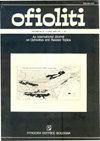A petrographic study of carbonate phases in the Ulten Zone ultramafic rocks: insights into carbonation in the mantle wedge and exhumation-related decarbonation
IF 1.3
4区 地球科学
Q2 GEOLOGY
引用次数: 10
Abstract
We present a comprehensive petrographic study on carbonates in orogenic mantle wedge-derived peridotites from the Ulten Zone (UZ) in the Eastern Italian Alps representing a fragment of the Variscan belt. These peridotites are found in ultramafic bodies incorporated in high-grade crustal rocks from a former continental slab and are characterized by highly variable mineral assemblages and microstructures, which reflect their evolution from spinel peridotite in a hot mantle wedge, to garnet peridotite after incorporation into the subducting slab and finally exhumation accompanied by retrogression. Carbonate phases in UZ peridotites are observed in diverse textural sites and can be related to particular petrographic peridotite types. Inclusions of dolomite and dolomite-breakdown products in primary spinel from coarse-grained protogranular peridotites indicate that carbon-bearing liquids were introduced into the mantle wedge at a time before achieving garnet stability. Discrete dolomite grains occur in fine-grained deformed garnet-bearing peridotite and are suggested to have formed simultaneously with hydrous phases (amphibole, apatite) from a carbon-bearing aqueous crustal slab-derived fluid during garnet stability. Intergrowths of calcite and brucite occur mainly in serpentinized fine-grained garnet-amphibole peridotites and are interpreted to be products of dedolomitization (CaMg(CO 3 ) 2 + H 2 O → CaCO 3 + Mg(OH) 2 + CO 2 ), thus decarbonation, during exhumation. Veins of dolomite and calcite-brucite indicate secondary dolomite formation from carbon-bearing fluids due to interaction with slab-derived crustal fluids during retrogression on the exhumation path of the UZ peridotite. Magnesite veins and calcite veins that are texturally linked to alteration features are probably of low-temperature origin. In summary, this petrographic study reveals multi-stage carbonation of the UZ peridotites during residence in the mantle wedge and decarbonation with the release of a carbon species during low-temperature peridotite reaction with aqueous fluids leading to serpentinization accompanied by dolomite breakdown, thus providing important constraints on the carbon budget and carbon cycling in collisional settings. Overall, the ubiquity of carbonates in a variety of textural settings in the UZ peridotites suggests that the supra-subduction zone mantle in continental settings represents an efficient carbon trap.奥腾带超基性岩中碳酸盐相的岩石学研究:对地幔楔的碳酸化作用和与挖掘相关的脱碳作用的认识
我们对来自意大利阿尔卑斯山脉东部Ulten带(UZ)的造山地幔楔状橄榄岩中的碳酸盐进行了全面的岩石学研究,该橄榄岩代表了华力西带的一个片段。这些橄榄岩发现于超镁铁质岩体中,这些超镁铁质体包含在前大陆板块的高级地壳岩石中,具有高度可变的矿物组合和微观结构,反映了它们从热地幔楔中的尖晶石橄榄岩,到整合到俯冲板块中后的石榴石橄榄岩,最终折返并伴随后退。UZ橄榄岩中的碳酸盐相存在于不同的结构部位,可能与特定的岩相橄榄岩类型有关。粗粒原粒状橄榄岩原生尖晶石中白云石和白云石分解产物的包裹体表明,在实现石榴石稳定性之前,含碳液体曾一度被引入地幔楔中。离散的白云石颗粒出现在细粒变形的含石榴石橄榄岩中,并被认为在石榴石稳定期间与含碳含水地壳板衍生流体中的含水相(角闪石、磷灰石)同时形成。方解石和水镁石的共生主要发生在蛇纹石化细粒石榴石-角闪岩橄榄岩中,并被解释为脱绿石化的产物(CaMg(CO 3)2+H2 O→ CaCO3+Mg(OH)2+CO2),从而在剥露过程中脱碳。白云岩和方解石-水镁石脉表明,在UZ橄榄岩折返路径上的后退过程中,由于与板状地壳流体的相互作用,含碳流体形成了次生白云岩。与蚀变特征有结构联系的菱镁矿脉和方解石脉可能是低温成因。总之,这项岩相研究揭示了UZ橄榄岩在地幔楔中停留期间的多阶段碳酸化,以及在低温橄榄岩与含水流体反应期间释放碳物种的脱碳,导致伴随白云石分解的蛇纹石化,从而对碰撞环境中的碳预算和碳循环提供了重要的约束。总的来说,UZ橄榄岩中碳酸盐在各种结构环境中的普遍存在表明,大陆环境中的超俯冲带地幔代表了一个有效的碳陷阱。
本文章由计算机程序翻译,如有差异,请以英文原文为准。
求助全文
约1分钟内获得全文
求助全文
来源期刊

Ofioliti
地学-地质学
CiteScore
2.40
自引率
7.70%
发文量
1
期刊介绍:
Since 1976, Ofioliti provides an international forum for original contributions and reviews in the field of the geodynamics, petrology, geochemistry, biostratigraphy, stratigraphy, tectonics and paleogeography applied to ophiolitic terrains and modern oceanic lithosphere, including their sedimentary cover. Studies of topics such as geodynamics of the mantle, the evolution of orogens including ophiolites and paleoceanography are also welcome
 求助内容:
求助内容: 应助结果提醒方式:
应助结果提醒方式:


